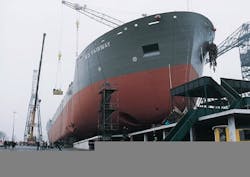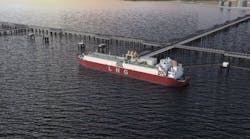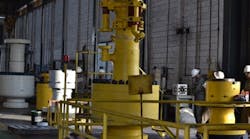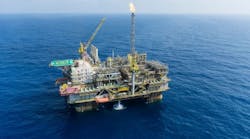The hull of the WD Fairway at its recent launch in The Netherlands.Dutch dredging specialist Boskalis has launched the hull for what will be one of the world's largest dredging vessels. The WD Fairway will be offered for construction of pipelines over very great lengths. It will have a hopper capacity of 23,425 cu metres and will be able to dredge in water depths up to 120 meters. This makes it well suited for large-scale projects in environmentally sensitive areas.
Trailing suction hopper dredgers load their holds with the aid of centrifugal pumps. Loading takes place while the vessel is under way via one or two suction arms which are lowered into the water and trailed along the seabed. Discharge is normally via bottom doors or by pump. The WD Fairway has numerous innovative `green' features such as overflow and recirculation systems designed for protection of the marine environment.
Immediately following the launch of the hull from the Verolme Shipyard Heusden last November, the keel was laid for a second dredger of the same size which is to be commissioned in June next year. The WD Fairway was then towed to Rotterdam for installation of the accommodation module and the bridge.
Boskalis is investing around $93 million in each of the vessels. As cost-effective dredging hinges on the ability to dredge and transport the maximum amount of material in the minimum of time, dredging speed is expected to become more critical as the scale of dredging operations increases.
AC electric tensioners counter failure risk of DC
The pipe tensioner consists of two gearbox-driven tracks. On the inner side, each track is supported by roller groups suspended on springs with restricted, adjustable strokes. The tracks are clamped to the pipe by means of hydraulic accumulators. The clamping system is flexible and fail-safe, even in cases of falling hydraulic pressure.
Non-weight coated field joints can be accommodated for passage while maintaining tension on the pipeline. As a rule, the trackshoes will not touch the hot field joints if the pipeline is provided with substantial weight coating. Overall pipe diameter variations up to 2 inches, as caused by anodes, are absorbed by the reaction of the two clamping cylinders with the accumulators.
The pipe tensioner can be adjusted both horizontally and vertically. It is also possible to adjust the height of the pipeline above the ramp in case the pipe tensioner is in a position where the pipeline shows an overbend curve. The pipe tensioner can be opened fully for passage of, for example, a pipe valve or a fitting. For control of the device, sensors register the tension from load pins mounted within the machine.
SAS' digital AC drive unit comprises frequency converter equipment for high speed and torque control of the electric motors. The system features modern power semiconductors, digital control and interfaces to various automation and PC-based systems. A remote control console is provided with a 10-in. (640x480 pixels) menu-based touch screen and PLC equipment.
Though SAS makes both horizontal and vertical pipe tensioners, the company recommends the horizontal version because of its low profile and weight; the option of balancing equally the load distribution on both ends of the tracks; no coating debris falling into the track gear; and easy vertical adjustment.
The system features:
- modern power semiconductors
- digital control
- digital interfaces to various automation and PC-based systems.
- A remote control console is provided with a 10-in. (640x480 pixels) menu-based touch screen and PLC equipment.
Copyright 1997 Offshore. All Rights Reserved.





